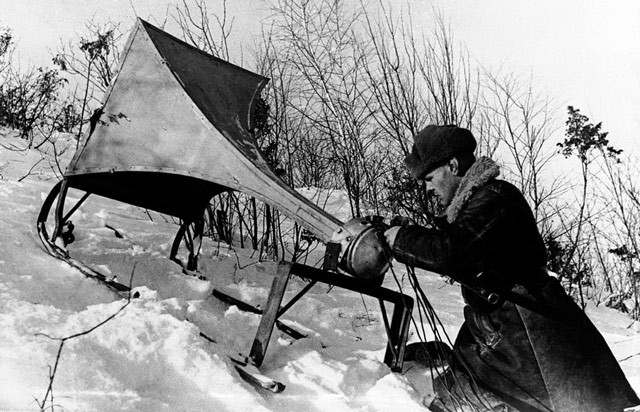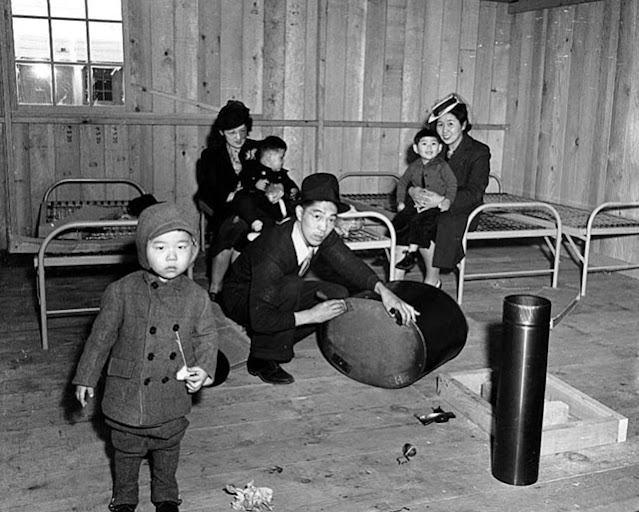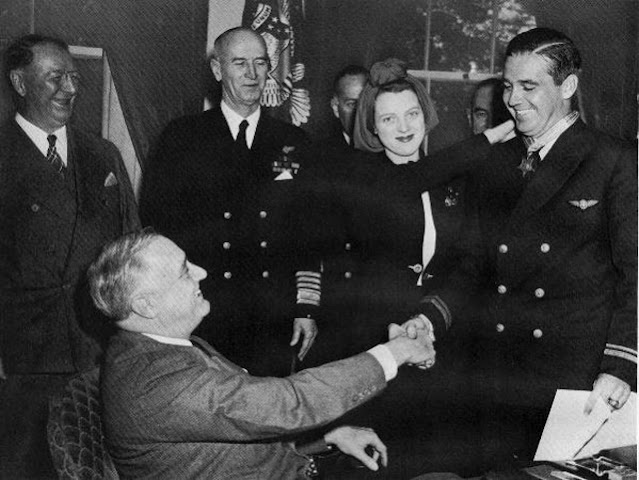Tuesday 21 April 1942
 |
| A Soviet soldier sets up a loudspeaker to broadcast propaganda to German soldiers somewhere in Russia, 21 April 1942 (AP Photo). |
Battle of the Pacific: From a safe house in Chuchow (Quzhou), China, Lieutenant Colonel James Doolittle manages to get a message out to Washington, D.C. on 21 April 1942. In the message, he tells his superior officer, General "Hap" Arnold, that:
[The] mission to bomb Tokyo has been accomplished. On entering China, we ran into bad weather and it is feared that all planes crashed. Up to the present five fliers are safe.
Hap Arnold himself is receiving other information that indicates that most of the other Doolittle crewmen are safe, but that the Japanese also had captured a few. Doolittle himself is apprehensive that he faces a court-martial when he returns to the States due to the likely loss of all of the bombers in the mission (only one survives intact but is interred in the Soviet Union near Vladivostok).
President Roosevelt finally addresses the press today about the Doolittle raid. He confirms that US planes indeed had bombed Japan but for national security reasons gives few details. When a reporter asks Roosevelt what "base" the bombers had flown out of, Roosevelt takes the advice of an aide (Samuel Rosenman) and replies, "They came from our new secret base at Shangri-La." Of course, everyone at the time realizes that this was the fictional location in James Hilton's recent best-selling novel "Lost Horizon." Doolittle himself is not mentioned and the public is not given any more details about the raid until April 1943.
In China, the Japanese occupation forces carry out a retaliatory action for the Doolittle Raid known as the Zhejiang-Jiangxi Campaign. This leads to the deaths of an estimated 250,000 Chinese people over the course of the next month.
Battle of the Indian Ocean: The Japanese advance in Burma continues as the Allies slowly retreat northwest toward India. Kyidaunggan on the road to Mandalay falls to the Japanese 18th Infantry Division.
Eastern Front: A German relief force under General Seydlitz (Operation Brückenschlag) manages to push through fading Soviet resistance in Ramushevo and reach the Lovat River. This creates a corridor (over the river) to the besieged garrison of almost 100,000 troops in the Demyansk pocket for the first time in ten weeks. The men of SS "Totenkopf" trapped in the pocket have battled their way to the river through the deepening spring thaw ("Rasputitsa") that makes any troop movement through the woods extremely difficult. This is a major German victory that deepens Adolf Hitler's belief that surrounded troops can always be rescued given sufficient will within leadership to do so.
General Franz Halder, not yet informed of the success at Demyansk, notes blandly in his war diary, "On the whole quiet, except for new attacks on the Volkhov."
In Crimea, the enhanced Luftwaffe forces remain very active. General Wolfram von Richhtofen has built the air force's Fliegerkorps VIII presence there up to the standards of an entire air fleet as planes and pilots return from the Reich after being restored to top service over the winter. Planes of KG 55 today damage the Soviet minesweeper Komintern and sink 4156-ton transport ship Kalinin at Novorossiysk. These raids are greatly interfering with Soviet General Kozlov's attempts to supply and reinforce his troops on the Kerch peninsula.
 |
| U-571 and U-459 at sea, with a supply submarine refueling another submarine using a fuel hose (which the crew is grabbing with a hook), 21 April 1942 (Jostling, Federal Archive Fig. 101II-MW-4835-12). |
In a rare display of independence, the Soviet Stavka (military high command) notes the obvious trends in Crimea and asks Stalin to consider evacuating the Kerch position. Stalin refuses and today orders preparations for yet another offensive against the German 11th Army units holding the Parpach Narrows to break through to Sevastopol. Stalin also refuses to send any more reinforcements, considering the forces he already has allocated to Crimea to be adequate for the mission. General Kozlov now is placed in an impossible position, with inadequate forces for an offensive, no hope of getting any more, and orders to put his forces into an attack orientation that will make them vulnerable to an attack. German General Manstein is planning exactly such an attack for the earliest time after the Rasputitsa subsides.
The Wehrmacht requests Italian naval forces for an unusual mission that will go under the code name Operation Hobgoblin. This is an attempt to interdict Soviet naval traffic across Lake Ladoga that is keeping Leningrad from surrendering. The Soviets are believed to have a large force of 6 gunboats, 2 large and 5 small torpedo boats, 32 armed minesweepers, 9 armed transport ships, 17 armed tugboats, and one submarine, plus another 25 other boats on the lake. The Italians are renowned for their small-boat force and immediately agree to supply four torpedo boats (MAS 526 to 529) of the 12th MAS Flotilla, commanded by Capitano di Corvetta (Lt-Commander) Bianchini. He has four officers, 19 NCO's, and 63 other ranks. These forces will be supplemented by Kriegsmarine Siebel ferries once the ice on the lake melts.
 |
| Commander-in-Chief Western Approaches Admiral Sir Percy Noble's personal aircraft, photographed on 21 April 1942. "The Admiral's plane, An Airspeed AS 6J Envoy III (P5629). Note the Admiral's flag on the nose." Note the overcast skies and rainwater on the airstrip, foul weather that day on the Channel Front (© IWM A 8386). |
European Air Operations: For the second day in a row, there are no operations due to ground haze and light rain.
Battle of the Atlantic: U-576 (Kptlt. Hans-Dieter Heinicke), on its fourth patrol out of St. Nazaire, torpedoes and sinks 5102-ton US freighter Pipestone County about 475 (880 km) miles east of Cape Henry, Virginia. The U-boat stops and gives provisions to one of the four lifeboats after questioning the survivors. All 46 aboard survive, rescued by USCGC Calypso, fishing vessel Irene and May, and Norwegian freighter Tropic Star.
U-201 (Kptlt. Adalbert Schnee), on its sixth patrol out of Brest, torpedoes and sinks 2027-ton Norwegian freighter Bris about 475 miles southeast of Wilmington, North Carolina. There are 4 deaths and 21 survivors.
U-84 (Oblt. Horst Uphoff), on its fourth patrol out of Brest, torpedoes and sinks 3014-ton Panamanian freighter Chenango about 60 nautical miles (110 km) southeast of Cape Henry, Virginia. There are 31 deaths and one survivor who is picked up by a Consolidated PBY Catalina of the US Coast Guard.
 |
| "The Duke of Gloucester inspects the Royal Marine Guard of Honour onboard HMS CLEOPATRA." Alexandria, Egypt, 21 April 1942 (© IWM A 8773). |
Battle of the Mediterranean: Heavy Luftwaffe attacks on Malta continue. Of the 47 Spitfire fighters flown to the island from USS Wasp (CV-7) in Operation Calendar on the 20th, already about 30 have been destroyed and many others damaged. The Axis planes also sink 392-ton Royal Navy trawler HMT Jade in Grand Harbor, Malta.
Italian dictator Benito Mussolini, noting Malta's crumbling defenses, asks Hitler to take the island using paratroopers (Fallschirmjaeger). This is something that Luftwaffe General Albert Kesselring has been urging as well. Hitler, however, refuses to use paratroopers in an offensive role due to the heavy losses on Crete. This may be a wise decision because the British intelligence services could prepare a hot welcome for paratroopers dropping on British-controlled territory just as they did on Crete due to the secret Enigma codebreaking team.
Royal Navy submarine HMS Torbay shells and sinks 170-ton Kriegsmarine patrol boat 13V2 Delpa II off Cape Drepano near the Corinth Canal.
Special Forces: No. 4 Commando, in conjunction with 50 men from the Canadian Carleton and York Regiment, (2nd Canadian Infantry Brigade) and some Royal Engineers conduct Operation Abercrombie. This is an overnight reconnaissance in force begun after dark on 21 April 1942 in the vicinity of the French coastal village of Hardelot. Continuing a pattern of widely varying results of these commando raids, the raid accomplishes very little after a great deal of effort and planning. Among other issues, the Canadian contingent loses its way in the night and has to completely abort its participation in the mission.
While no meaningful opposition is encountered, the Commandos lack time to accomplish minimal mission objectives such as destroying a nearby searchlight array. There are no casualties on either side. The raid is most notable for being the first time that the new LCS (Landing Craft Support) is used, providing valuable experience for future missions.
Partisans: The German authorities in France shoot 20 French hostages in retaliation ("complicity") for the successful British Commando raid on St. Nazaire in March 1942. Shooting hostages for attacks on German soldiers already has become an established practice by the occupation authorities.
 |
| A British Royal Navy Grumman Martlet IV (Grumman F4F-4B) at Naval Air Station, Anacostia, Washington D.C. (USA), on 21 April 1942, after application of British markings. Official U.S. Navy photo NH 89676 from the U.S. Navy Naval History and Heritage Command. |
POWs: French General Henri Giraud reaches the presumed safety of Switzerland after a daring escape from the high-security POW camp at Königstein Castle near Dresden. Giraud accomplished his escape by using bedsheets and other articles to make a 150-foot (46 m) rope to lower himself down from his prison cell. Giraud had the advantage that many other POWs did not of having established a simple code in his letters home to inform his family of his plans. A Special Operations Executive (SOE) officer then met him and escorted him to Switzerland.
Giraud is stopped at the border by two Swiss border guards. At times these guards are known to have returned POWs to the German authorities, but these guards take this prize prisoner to Basel instead. News of Giraud's escape creates a sensation in France. Giraud then becomes a murky figure in murky French politics, remaining loyal to Pétain and the Vichy government but refusing to cooperate with the German authorities. Heinrich Himmler eventually tries to have the Gestapo assassinate Giraud but fails. Giraud refuses Pierre Laval's attempts to force him to cooperate with the Germans, but Laval does not turn Giraud over to the Gestapo when he has the chance. The Allies give Giraud the codename Kingpin and plan to make use of him when they invade French North Africa. After a long series of important appointments and politically charged events, they find out that Giraud is a loose cannon and cut their ties with him.
US Military: US Navy aviator Lt. Edward "Butch" O'Hare becomes the first naval recipient of the Medal of Honor. O'Hare receives the award for exploits on 20 February 1942 that his commanding officers, including Vice Admiral Wilson Brown (commander of Task Force 11) and Captain Frederick C. Sherman, believed may have saved his aircraft carrier USS Lexington from destruction. O'Hare Airport in Chicago, Illinois, is named after Lt. O'Hare, who later went missing near the Gilbert Islands on 26 November 1943 and was declared dead exactly one year later.
US Government: President Roosevelt orders the seizure of all patents owned or controlled by enemy nations. This action is mainly directed against Germany, which has close ties to several important US industries.
The Roosevelt administration okays the "Big Inch" pipeline from Texas to New York. This is in response to the recent loss of many oil tankers off the US east coast during German Operation Drumroll (Paukenschlag).
The wife of the last US ambassador to Vichy France, Louise Leahy, passes away unexpectedly of an embolism. Admiral Leahy already has been ordered to return to the United States at the end of the month and this is a crushing experience to him. He will leave France at the beginning of May 1942.
 |
| Japanese American evacuees, Camp Harmony (Puyallup Assembly Center), 1942 Photo by Howard Clifford, Courtesy UW Special Collections (UW526). |
American Homefront: In Seattle, Washington, evacuation announcements are posted on telephone poles, bulletin boards, and other highly visible public places. These direct Japanese-American to leave the city in three groups on the following Tuesday, Thursday, and Friday. The Japanese population of Seattle is around 7,000 people, with about another 7,000 living in the remainder of Washington State. Of these 14,000, a total of 12,892 persons of Japanese ancestry wind up in internment camps, first in the Puyallup assembly center and then to Minidoka in Idaho. The FBI already is arresting members of this community.
The San Francisco News on 21 April 1942 prints a report by Harry Ferguson of United Press giving an eyewitness account of the Manzanar internment camp. Ferguson reports that newcomers "found comfortable wooden buildings covered with tar paper, bathhouses and showers and plenty of wholesome food." He quotes an internee who calls Manzanar a "Nice place to live" that is "better than Hollywood." However, "Those whose sympathies lie with Japan are keeping quiet about it."
In another article in the San Francisco News today, the San Francisco Board of Supervisors is reported as suggesting "rehabilitation" of "Little Tokio." This "rehabilitation" actually means obliterating it. The article states:
All parties concerned have endorsed the idea of slum clearance programs for the section, but there have been differences over whether Federal or private money should be used.
The article suggests that there is some urgency to the matter as other minorities are quickly moving into the areas abandoned by the Japanese-Americans.
 |
| Look magazine, 21 April 1942. |
April 1942
April 1, 1942: Convoys Come to the USAApril 2, 1942: Doolittle Raiders Leave Port
April 3, 1942: Japanese Attack in Bataan
April 4, 1942: Luftwaffe Attacks Kronstadt
April 5, 1942: Japanese Easter Sunday Raid on Ceylon
April 6, 1942: Japanese Devastation In Bay of Bengal
April 7, 1942: Valletta, Malta, Destroyed
April 8, 1942: US Bataan Defenses Collapse
April 9, 1942: US Defeat in Bataan
April 10, 1942: The Bataan Death March
April 11, 1942: The Sea War Heats Up
April 12, 1942: Essen Raids Conclude Dismally
April 13, 1942: Convoy QP-10 Destruction
April 14, 1942: Demyansk Breakout Attempt
April 15, 1942: Sobibor Extermination Camp Opens
April 16, 1942: Oil Field Ablaze in Burma
April 17, 1942: The Disastrous Augsburg Raid
April 18, 1942: The Doolittle Raid bombs Japan
April 19, 1942: British in Burma Escape
April 20, 1942: The Operation Calendar Disaster
April 21, 1942: Germans Relieve Demyansk



No comments:
Post a Comment